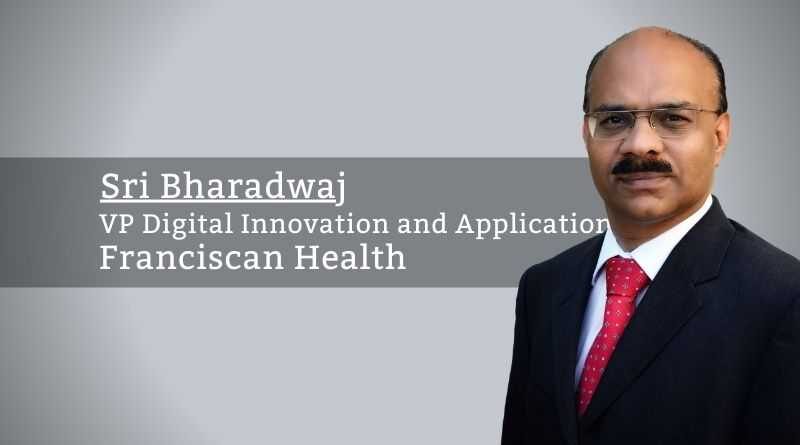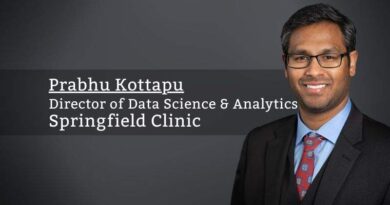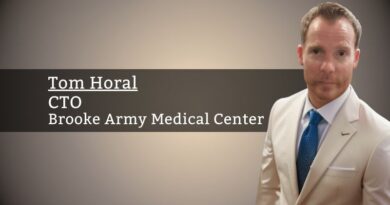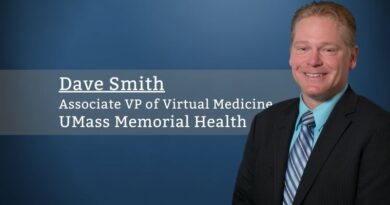Seize the moment and drive change for the better! COVID-19! A Catalyst for Innovation
By Sri Bharadwaj, VP Digital Innovation and Applications, Franciscan Health
The Changing Healthcare Business Model: Do we really need an EMR?
It is interesting that we see that “necessity is the mother of invention” coming to become so true in the times of the pandemic. Using the past 18 months as a catalyst for innovation, the healthcare industry has been transformed to accept the ability for remote care. It has improved patients’ ability to take care of themselves. We have seen anecdotal information about patients getting better at home using hospital at home capabilities.
We still live in a hefty fee-for-service world. We have some sprinkling of value-based care, but our system is based on traditional medicine. Another key factor was based on how the system reimburses for care. The question is: Is this the most effective? Are we going to continue to do this for the next 20 years while we keep complaining that our healthcare costs us too much with lower outcomes? We, as an industry must change. We need to embrace the catalysts and catapult us to a broader outcomes-based model. Situational awareness and incentive to life are key to understanding the patient and the delivery system for better outcomes.
The tech is available today, however, our shackles of regs and compliance force us to thwart newer models of care.
The Dichotomy (FFS and VBC): Can we co-exist in this dichotomy model of fee for service (FFS) and value-based care (VBC) together? Some evidence points to us that it is hard. Hard on the people who work in it (clinicians and RVUs) and hard on the people who experience it (patients – perceived loss of freedom). The administrators perceive a loss of revenue due to lost inpatient bed days while the VBC physician is trying to keep the patient out of the hospital in a VBC world. Compromise and conquer for better outcomes.
Patients and their info: Why do we make it this hard? Information is what gives our patients power? We saw this during the time of the pandemic. Why do we not provide the information our patients need in their portals? Example: Link lab results directly with approved ranges so they can understand what it means (they do this anyways – “Hello Google”). How many other consumers have the same range in their lab values? How do they connect with them? What did those other consumers do to get back in the range? Ultimately that is the outcome the physician expects out of the patient, correct?
These are the questions we must ask ourselves. Why cannot we provide complete transparency to their eligibility? Can a customer execute a HIPAA 270/271 transaction to understand what is their eligibility in English? Can the customer arm themselves with pre-authorization so that they do not have to rely on the provider’s office or the hospital to do that? Empower the patient (rather, get them to do the work. When last did we call an agent to book our flights?). Are we afraid that our patients will get better care somewhere else? If so, is that not providing better value to the healthcare system as a whole?
A few weeks ago, we talked with the Center for Medicare and Medicaid Innovation (CMMI) leadership. The ability to get virtual care is here to stay. We can extend every possible opportunity for the patient to get care on their own at home.
At Franciscan, we are making a paradigm shift in care processes. For example, we did what we call virtual inpatient multi-specialty rounding. A group of consulting physicians: a pulmonologist, a cardiologist, an intensivist, a hospitalist and a dietician meet and talk about a patient while the patient is in bed through a virtual iPad-based TEAMS call. Change meds, order labs and collaborate care leading to a lower length of stay. Ok! It is not that easy, but you get the point. Changing our care processes will deliver better value and ease physician burnout (six patients in half an hour).
Here is another one. A patient does not want to walk in to see his cardiologist but is willing to drive to the clinic due to poor internet (for a virtual visit). He drives into the parking lot; an iPad is given to him and he has a virtual visit and gets his prescription with his favorite pharmacy on his way home. Could we convert all visits this way if the patient does not have to drive in?
The Hospital – is considered the epitome of care today. But is it so? We have then to take care of CLABSI, CAUTI, Sepsis and dozens of hospital-acquired conditions while the patient is in. But we have seen evidence of the dozens of patients who got faster and better care if they stayed at home. Not all patients have the capability, but can we allow those patients who can do that to stay home and deliver virtual care maybe thrice a day?
The EMR – a cornerstone of documenting for the sake of compensation. While we have taken every possible action to drive discrete data capture, do we need that in an AI-based natural language processing (NLP) world? Can we not make this all interactive that the physicians can talk to their patients while the ambient sound system captures the conversation and auto-create a note and bills for it? The tech is available today, however, our shackles of regs and compliance force us to thwart newer models of care. Guess what? We have almost all our data on the internet and are willing to freely share with other patients to learn what they did to get better. And, of course, we are “death by consent” conscious.
Unless we think globally, we cannot change. Seize the moment and drive change for the better! Hopefully, we all will come out with better outcomes, with lower cost and greater access in the next 15-20 years.



